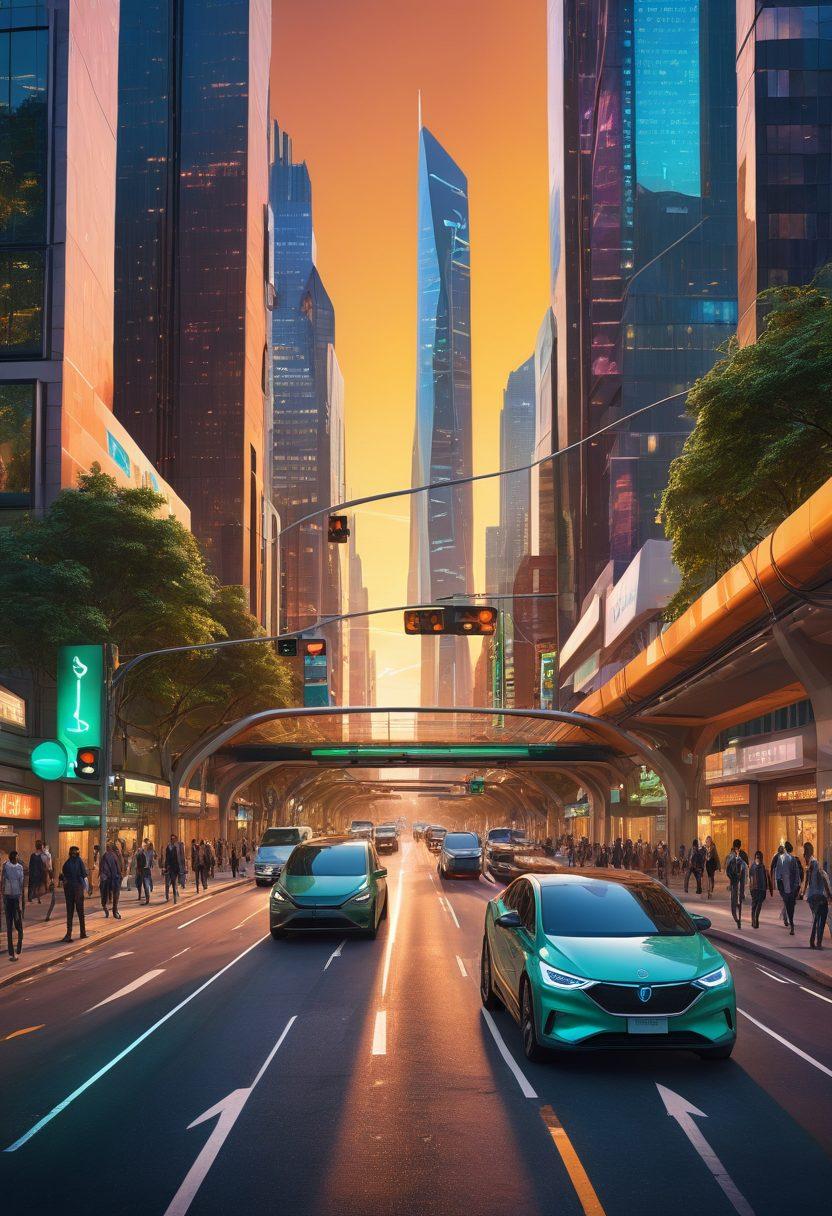Unlocking Urban Mobility: The Future of Ride Sharing and On-Demand Transportation
In the bustling heart of modern cities, the way we get around has undergone a seismic shift in recent years. Gone are the days when hailing a local taxi meant standing on the corner, waving frantically and hoping for a ride. Today, ride sharing has revolutionized urban transport by providing convenient, app-based taxi solutions that enable anyone to share a ride with just a few taps on their smartphone. This transformation in mobility services not only addresses the growing demand for efficient transportation but also reshapes our very understanding of urban life.
Imagine stepping out of your front door, tapping a transport app, and within minutes finding yourself swiftly connecting to your destination. The beauty of ride sharing lies in its user-friendly interface that puts the power of transportation at your fingertips. It’s not just about getting from point A to point B anymore; it’s about optimizing your journey and experiences along the way. As we delve into the intertwined destinies of commuters and technology, it's clear that on-demand rides are no longer a luxury but a necessity.
"In the chaos of city life, every second counts," someone once said, and with ride hailing services leading the charge, everyone can now experience the thrill of swift mobility. With options ranging from vehicle hire to chauffeur services, commuters relish in the historical shift from rigid schedules of public transportation to personalized journeys. A ride booking can be done in seconds, and with fare estimators included in many transport apps, passengers can effortlessly navigate their travel budget without the hassles that once accompanied taxi services heaped with surprise fees.
We also can’t overlook how ride sharing impacts logistics and the dynamics of shared commuting. By promoting a culture of carpooling, this innovative approach to urban transport actively diminishes congestion and pollution. One could argue that choosing to share a ride is not merely about saving money; it's a step toward fostering a greener, more sustainable city. It might even inspire you to ask: how can each of us contribute to this collective movement? Beyond individual choices, how does the ride sharing economy alter the future of urban planning and infrastructural development?
Ultimately, the future of urban mobility is not just in the hands of tech developers or city planners; it's a symbiotic relationship with the individuals who choose to embrace these services. Every time you decide to share a ride, you are shaping the kind of transformative impact ride sharing has on urban transport. So next time you find the streets buzzing with on-demand vehicle hire options at your disposal, remember: your choice to engage with these mobility services is not just an act of convenience—it's a revolutionary step toward creating the cities of tomorrow.
The Rise of On-Demand Rides: What It Means for Commuters and Beyond
Imagine stepping outside your home, tapping a few buttons on your phone, and within minutes, a smooth-riding car arrives to whisk you away to your destination. This isn't a scene from a futuristic movie; it’s the reality of on-demand rides, a pivotal component of ride sharing and urban transport. As traditional taxi services grapple with fierce competition from innovative mobility services, the landscape of transportation is rapidly evolving. What does this shift mean for commuters and the way we navigate our bustling cities?
The rise of on-demand rides is not just about convenience; it offers myriad benefits for commuters. With the help of a transport app, you can easily book a ride or share a ride with others going in the same direction. The beauty of ride hailing lies in its flexibility—it caters to your needs without the hassle of waiting for public transportation or the cost of owning a car. According to a recent study, 70% of commuters reported that they now prefer app-based taxi services for their daily travels. This shift creates a more efficient and streamlined urban transport network, reducing time spent in transit and increasing productivity.
One might ask, "What about the costs?" The advent of fare estimators in transport apps has revolutionized how we understand expenses related to commuting. By comparing prices between local taxi services, vehicle hire, and other chauffeur services, commuters can make informed choices that fit their budgets. Furthermore, the economic implications are significant; as demand for ride booking increases, local drivers benefit from an influx of customers, potentially boosting the economy in urban areas. Imagine the possibilities: a city where commuting feels seamless and accessible to everyone.
But not all benefits are financial. The rise of on-demand rides has a significant impact on reducing traffic congestion. In cities overwhelmed by vehicles, these mobility services can potentially decrease the number of cars on the road by fostering ride sharing culture. This not only minimizes carbon footprints but also improves air quality in urban centers. Cities are starting to encourage policies that favor ride hailing options, ensuring that urban transport remains sustainable, efficient, and environmentally conscious.
So, what does the future hold for on-demand transportation? As technology evolves, we might soon see the integration of electric vehicles and autonomous cars into the ride sharing equation. This is just the tip of the iceberg when it comes to urban mobility innovations. Commuters can expect to see enhanced chauffeur services and increasing accessibility to car rental options. The question on everyone’s mind is: How ready are we to embrace this change in our daily lives? With the rapid adoption of ride sharing and on-demand transportation, one thing is clear: the way we perceive mobility is destined to transform dramatically in the years to come.
From Cars to Apps: Exploring the Future of Taxi Services and Mobility Solutions
In the bustling heart of urban jungles, the incessant hum of engines and the intricate dance of taxis and ride-sharing vehicles have transformed commuting from a mere duty into an experience of adventure. Imagine stepping outside your door and – within mere minutes – having a ride booked through a transport app, whisking you away to your destination. Gone are the days of fumbling for cash or navigating complicated fare structures with traditional taxi services. Instead, we are embracing a new age of taxi services and mobility solutions that promise efficiency and convenience. Welcome to the future of urban transport, where ride-sharing and on-demand transportation are paving the way for seamless mobility.
With apps offering ride-hailing at the touch of a button, the concept of vehicle hire and transport networks has revolutionized how we think about travel. But are we ready to fully embrace this shift? “The only constant in life is change,” said Heraclitus, and change is indeed the heartbeat of our transportation landscape. From local taxi services to luxury chauffeur services, variety abounds in the choices we now have. It begs the question: how can we leverage these innovations to not just ease our day-to-day commute, but to enrich our collective urban experiences? The answer lies in understanding the full potential of these mobility services.
Let’s take a journey back to the early days of city transport. For many, a simple car rental seemed the most viable solution; however, the challenges of finding parking, negotiating fees, and managing vehicle maintenance made it less desirable. Fast forward to today, where ride-sharing has emerged as the powerful alternative, allowing anyone to share a ride without the burdensome responsibilities of ownership. As we continue to share a ride, we foster environments that can reduce congestion and even emissions, creating a more sustainable urban environment. Who knew that an app-based taxi service could promote eco-friendly behavior?
But what about the logistics? The experience of ride booking could make or break your travel experience. Thankfully, technology has answered the call with fare estimators that help you plan your budget before stepping into a vehicle. Commuter services are fine-tuning their offerings, ensuring riders are not only picked up but also dropped off efficiently, allowing for more time to be spent enjoying our cities rather than fighting through traffic. Just think about it: what could you do with those extra minutes that once slipped away in a rush hour gridlock?
In conclusion, the future of transportation isn’t just about getting from point A to B. It’s about redesigning our urban landscapes into leisurely navigable spaces that empower communities. As travelers, we have a unique chance to shape the future, influencing our transport app preferences and encouraging a culture of sharing and sustainability. So, next time you pull out your phone to book an on-demand ride, reflect on how fortunate we are to have so many options at our fingertips. It’s not just a journey; it’s a movement toward a smarter, more interconnected world.


